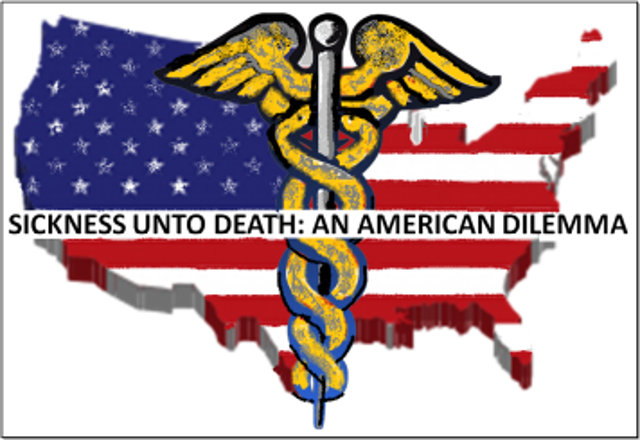Murphys, CA…Ever been to a hospital? Apparently, not President Trump. How else to explain his apology for not initially getting a “repeal and replace” bill through Congress, by incredulously asking of healthcare, “who knew it was so complicated?”

This is a series of eight articles on a single theme to be released once a week. Copyright license granted under
Ever been to a hospital? Apparently, not President Trump. How else to explain his apology for not initially getting a “repeal and replace” bill through Congress, by incredulously asking of healthcare, “who knew it was so complicated?” Nevertheless, I want to give the President credit for illustrating what most professional health care workers know, and is largely unobserved by the general public — health care is complicated.
What Do Americans Want?
Take the commonly accepted primary goal of health care — to help people live healthier and longer lives — which turns out to be an enormously complicated objective. Do we, for example, take all measures to sustain someone’s life even if they have no cognition of what is going on around them? Do we provide expensive chemotherapy treatments to someone with lung cancer who insists on smoking cigarettes? Do we emphasize preventative care to reduce pathologies? When do providers intervene when they observe someone hurting themselves? When does the government get involved when there is a determination that a workplace environment is hazardous to workers? Every question provokes a surplus of contradictory responses. How do we sort this out without asking our Congress to prescribe our health care. Health care is not trivial — and being a Democrat or a Republican does not simplify any decision we make about it. It’s a fundamental human problem.
At the risk of losing my readers, let’s consider some numbers.
Poor Use of Resources
In 2012, 130 million patients visited emergency rooms for a variety of reasons, only ten percent of which required admission to the hospital for inpatient care. (CDC 2016). Most of the reported problems included headache, fever, bad cough, etc. In 2013, private practitioners recorded 70 million scheduled patients. (Physician Foundation 2017). Thus, there were twice as many visits to an emergency room than to a doctor — the emergency room was the family doctor. Given that emergency room visits cost nearly twenty times a comparable visit to a private physician and thirty times the cost of a family clinic, something is clearly wrong with how we provide health care in this country.
Size of Healthcare Industry with Other National Priorities
The U.S. health care system has over 900,000 professionally active physicians and surgeons and more than 4 million professional nurses. In addition, there are lab technicians, pharmacists, physical therapists, nursing aides, nutritionists, psychotherapists and a host of other direct service professionals, as well as all employees of the broader health care eco-system like the information technologists, insurance representatives, administrators, pharmaceutical representatives, researchers, community health educators, for a total of 12 million health care workers (Kaiser Family Foundation 2017). By contrast, the U.S. Defense Department has 2.9 million employees (active forces, civilians, and National Guard). The health care industry is four times the size of the Pentagon and that doesn’t count research and development in the pharmaceutical and medical device industry.
In the U.S., there are 5,500 hospitals with nearly 900,000 attended beds in the U.S. for those patients with more serious conditions or for inpatient surgery. (American Hospital Association 2017). The U.S. Department of Defense maintains some 800 bases around the world — including training, active combat, command, storage, and intelligence bases.
Thousands of Bad Guys
Let’s not forget, however, why we even need a health care system to begin with — diseases and injuries. Our bodies are susceptible to all sorts of dysfunction — pathogens (viruses, bacteria), genetic malformations, bio-chemical imbalances, developmental disorders, and environmental (ecological as well as social). According to the World Health Organization, there are 30,000 categories of diseases in the world (of which 7,000 are considered rare). Having once inadvertently ingested a rare parasite while travelling overseas, I can attest to just how many laboratory tests were required to identity the pathogen. As the little critter had not been seen in the U.S. before, it took substantial experimentation to find an effective antibiotic.
Fortunately, the number of serious diseases in the United States is much smaller. In 2014, for example, the most prevalent causes of death in the U.S. were forty-two different forms of heart disease (23% of all deaths) and ninety-seven types of malignant neoplasms (cancer) which caused another 23% of deaths. Emphysema, accidents, Alzheimer’s disease, strokes, suicides, and diabetes account in toto for 27% of all deaths. Even this subset of common ailments requires a large number of technicians, techniques, physicians, nurses, and resources to identify and treat the cause and symptoms.
Can You Afford to Get Sick?
Planning for and providing health care is complicated and the President is right to call it out. The elephant in the room, when speaking of the complexities of health care in America, is not just who gets covered, or why they get covered, or even how they get covered. It is if they get covered and the gatekeepers for that complex topic are the insurance companies, to which I will return in Part VI.
[To be continued next week]



you touch on the behavioral issues, my question is how much should the government be responsible for if people are not willing to take some responsibility for their own health? In the long term good nutrition and “exercise” behaviors can greatly contribute to longer term health, resulting in better health,reduced medical and disability costs. Maybe incentivizing individuals and families in the form of discounted premiums and out-of-pocket expenses could help to make us all healthier too. Imagine a US health policy and program that actually makes you healthier. Pardon the sarcasm.